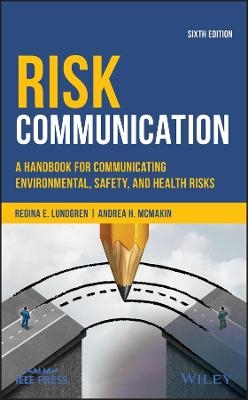
Risk Communication
Wiley-IEEE Press (Verlag)
978-1-119-45611-7 (ISBN)
Now in its sixth edition, Risk Communication has proven to be a valuable resource for people who are tasked with the responsibility of understanding how to apply the most current approaches to care, consensus, and crisis communication. The sixth edition updates the text with fresh and illustrative examples, lessons learned, and recent research as well as provides advice and guidelines for communicating risk information in the United States and other countries.
The authors help readers understand the basic theories and practices of risk communication and explain how to plan an effective strategy and put it into action. The book also contains information on evaluating risk communication efforts and explores how to communicate risk during and after an emergency. Risk Communication brings together in one resource proven scientific research with practical, hands-on guidance from practitioners with over 30 years of experience in the field. This important guide:
Provides new examples of communication plans in government and industry, use of social media, dealing with "fake news," and new digital tools for stakeholder involvement and crisis communications
Contains a new chapter on partnerships which covers topics such as assigning roles and expectations, ending partnerships, and more
Presents real-world case studies with key lessons all risk communicators can apply.
Written for engineers, scientists, professors and students, land use planners, public health practitioners, communication specialists, consultants, and regulators, the revised sixth edition of Risk Communication is the must-have guide for those who communicate risks.
REGINA E. LUNDGREN is an independent consultant in risk communication, public involvement, and science and strategic communication. For more than 30 years, she has specialized in communicating environmental, safety, and health risks to lay audiences. You can learn more at her website at http://www.rlriskcom.com. ANDREA H. MCMAKIN is a communication specialist at the U.S. Department of Energy's Pacific Northwest National Laboratory in Richland, Washington. For more than 30 years, she has directed, taught, advised on, and carried out the communication of scientific, technical, and risk-related information.
List of Figures XVII
List of Tables XIX
Preface XXI
About the Authors XXIII
1 INTRODUCTION 1
To Begin 2
The Risk Communication Process 6
Audiences, Situations, and Purposes 8
References 8
PART I UNDERSTANDING RISK COMMUNICATION
2 APPROACHES TO COMMUNICATING RISK 11
Cross-Cutting Risk Communication Approaches 12
Care Communication Approaches 20
Consensus Communication Approach 23
Crisis Communication Approaches 24
Summary 26
References 26
Additional Resources 28
3 LAWS THAT MANDATE RISK COMMUNICATION 29
Comprehensive Environmental Response, Compensation, and Liability Act 30
Emergency Planning and Community Right-to-Know Act 31
Executive Order 12898, Environmental Justice in Minority Populations and Low-Income Populations 34
Executive Order 13045, Reduce Environmental Health and Safety Risks to Children 34
Food and Drug Administration Regulations on Prescription Drug Communication 35
National Environmental Policy Act 35
Natural Resource Damage Assessment 36
Occupational Safety and Health Act 37
Resource Conservation and Recovery Act 39
Risk Management Plan Rule 39
Privacy Rule 39
Other Government Inducements 40
Summary 42
References 42
Additional Resources 43
4 CONSTRAINTS TO EFFECTIVE RISK COMMUNICATION 45
Constraints on the Communicator 45
Constraints from the Audience 55
Constraints for Both Communicator and Audience 63
Summary 65
References 65
Additional Resources 67
5 ETHICAL ISSUES 69
Social Ethics 70
Organizational Ethics 77
Personal Ethics 82
Summary 85
References 85
Additional Resources 86
6 PRINCIPLES OF RISK COMMUNICATION 89
Principles of Process 90
Principles of Presentation 95
Principles for Comparing Risks 100
Summary 104
References 104
Additional Resources 105
PART II PLANNING THE RISK COMMUNICATION EFFORT
7 DETERMINE PURPOSE AND OBJECTIVES 109
Factors That Influence Purpose and Objectives 110
Reference 114
Additional Resources 115
8 ANALYZE YOUR AUDIENCE 117
Begin with Purpose and Objectives 118
Choose a Level of Analysis 119
Determine Key Audience Characteristics 122
Determine How to Find Audience Analysis Information 125
Incorporate Audience Analysis Information into Risk Communication Efforts 129
References 132
Additional Resources 133
9 DEVELOP YOUR MESSAGE 135
Common Pitfalls 136
Information People Want 139
Mental Models 141
Message Mapping and Message Development Templates 144
Health Risk Communication 144
Crisis Communication 147
References 150
Additional Resource 151
10 DETERMINE THE APPROPRIATE METHODS 153
Information Materials 153
Visual Representation of Risk 155
Face-to-Face Communication 156
The News Media 158
Stakeholder Participation 160
Technology-Assisted Communication 162
Social Media 163
Partnerships 164
Additional Resources 166
11 SET A SCHEDULE 167
Legal Requirements 167
Organizational Requirements 168
The Scientific Process 169
Ongoing Activities 169
Audience Needs 170
Reference 172
12 DEVELOP A COMMUNICATION PLAN 173
What to Include in a Communication Plan 174
Developing Risk Communication Strategies 177
References 183
Additional Resources 184
PART III PUTTING RISK COMMUNICATION INTO ACTION
13 INFORMATION MATERIALS 187
Constructing Information Materials 187
Guidelines for Specific Types of Information Materials 195
References 202
Additional Resources 202
14 VISUAL REPRESENTATIONS OF RISKS 203
Design Visuals for Specific Audiences and Uses 205
Match the Visual Portrayal to the Information to Be Conveyed 207
Pretest Graphics with Those Who Will Use Them 209
Using Visuals to Personalize Risk Information 213
Comparing Risks in Visual Formats 213
Static versus Interactive Visuals 216
Depicting Probability and Uncertainty 218
Warning Labels 227
Consider Using Action Levels 230
Ethical Portrayal of Risk Information 232
Using Visual Information in Group Decision Making 235
References 236
Additional Resources 239
15 FACE-TO-FACE COMMUNICATION 241
Constructing Face-to-Face Messages 242
Guidelines for Specific Types of Face-to-Face Communication 247
References 258
Additional Resource 258
16 NEWS MEDIA 259
The Roles of the News Media in Risk Communication 260
Understanding Cultural Differences 263
Guidelines for Interacting with the News Media 266
Getting the Word Out 275
Dealing with Fake News 279
References 281
Additional Resources 283
17 STAKEHOLDER PARTICIPATION 285
Requirements for Stakeholder Participation 286
Guidelines for Specific Types of Stakeholder Participation Activities 290
References 311
Additional Resources 312
18 TECHNOLOGY-ASSISTED COMMUNICATION 315
Choosing Technology-Based Applications 316
Workplace Risk Communication 317
Web-Delivered and Stand-Alone Multimedia Programs 322
Traditional Electronic Forums 327
Interactive Multimedia Programs in Public Places 328
Technology in Care Communication 331
Technology in Consensus Communication 332
Technology in Crisis Communication 336
References 343
Additional Resources 345
19 SOCIAL MEDIA 347
General Principles on Participating in Social Media to Communicate Risk 348
Sharing Content via Social Media 354
Engaging with Stakeholders 355
Monitoring Changes in Perception via Social Media 356
Guidelines for Specific Types of Social Media 358
Evaluating Social Media Effectiveness 362
Dealing with Fake News 364
References 367
Additional Resources 369
20 PARTNERSHIPS 371
Categories of Partnerships 372
General Principles for Working in Partnership 374
Working with Influencers 378
Evaluating and Ending Partnerships 381
References 383
Additional Resources 384
PART IV EVALUATING RISK COMMUNICATION EFFORTS
21 EVALUATION OF RISK COMMUNICATION EFFORTS 387
Why Evaluate Risk Communication Efforts? 387
The Meaning of Success 388
Types of Evaluations 391
Conducting the Evaluation 393
References 397
Additional Resources 398
PART V SPECIAL CASES IN RISK COMMUNICATION
22 EMERGENCY RISK COMMUNICATION 401
Understanding Emergency Risk Communication 402
Planning for the Unexpected 409
Communicating During an Emergency 436
Communicating After an Emergency 448
References 452
Additional Resources 456
23 INTERNATIONAL RISK COMMUNICATION 457
Recognize the Similarities 458
Account for Cultural Differences 459
Look for “Your” Risk in Other Countries 461
Plan for Cross-Country Communication 463
References 466
Additional Resources 468
24 PUBLIC HEALTH CAMPAIGNS 471
Understand Your Goals 472
Use Research to Design Campaigns 473
Use Multiple Methods to Reach People 474
When Things Go Wrong 479
Evaluate Success 481
References 485
Additional Resources 486
RESOURCES 489
General Risk Communication Resources 489
Environmental Risk Communication Resources 491
Safety Risk Communication Resources 491
Health Risk Communication Resources 492
Care Communication Resources 493
Consensus Communication Resources 493
Crisis Communication Resources 494
GLOSSARY 497
INDEX 501
| Erscheinungsdatum | 05.10.2018 |
|---|---|
| Sprache | englisch |
| Maße | 158 x 231 mm |
| Gewicht | 1021 g |
| Einbandart | gebunden |
| Themenwelt | Mathematik / Informatik ► Informatik ► Netzwerke |
| Naturwissenschaften ► Chemie | |
| Sozialwissenschaften ► Soziologie | |
| Wirtschaft ► Betriebswirtschaft / Management | |
| ISBN-10 | 1-119-45611-8 / 1119456118 |
| ISBN-13 | 978-1-119-45611-7 / 9781119456117 |
| Zustand | Neuware |
| Haben Sie eine Frage zum Produkt? |
aus dem Bereich


